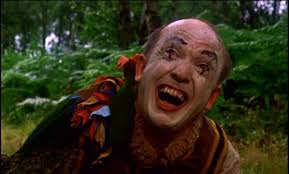Here's a modest, neglected gem, evoking the historical films of John Sayles as it dramatizes a minor, telling incident from the U.S. Civil War. It's rather stately (excuse the pun), but worth seeing, as U.S. history and for the ravishing beauty of the Appalachian forest (thus evoking the Jesse James subgenre, including
The Long Riders and
The Return of Frank James). It's the best-known film of Southerner Robby Henson (he wrote-directed 2002's
The Badge, with Billy Bob Thornton and Patricia Arquette).
 |
| Pharaoh's Army: war violates the Southern interior |
Advancing through Kentucky hollows, Captain John Abston (Chris Cooper) leads his Union troop on the farm of Sarah Anders (Patricia Clarkson) and son. With Sarah's husband away fighting for the South, the Yankees help themselves to livestock and provisions.
One of the-boys-in-blue has a fateful fall from a hayloft. His recuperation means an extended break for the rest, who have yet to "see the elephant" (or in today's military slang, "get some"). Rodie, restless Northerner who's lost a brother to the war, will accuse Abston of cowardice and "just wanting a poke." The latter can only be true (Patricia Clarkson), but Abston's no coward, just old enough to know war is a mess left by sleeping Senators and not worth getting shot over.
Appalachia was border country (West Virginia exists because the Virginia mountains went Union). Brother-against-brother was nowhere more common than in Kentucky and Tennessee, where bitter loyalties alternated town to town, man to man. Here, Kris Kristofferson is a South-leaning neighbor who, hearing of the Union incursion, sends his slave to snipe. Completing a sketched culture clash, the Yankees mock the patrician not doing his own fighting; Kristofferson ignores them (he also speaks the title phrase, referring to the Union Army). The intransigents acquainted, tragedy unfolds, as regional rivalry leaps generations.
In addition to the excellent cast and cinematic setting, the film has a mournful (and presumably authentic) score. Among recent films peripheral to the Civil War,
Pharaoh's Army is superior to the rather stilted
The World Made Straight (2015), and nearly as attractive as the large-canvas
Seraphim Falls (2006).
A late, Leftist article-of-faith insists America's Civil War
was fought over slavery, after all. Some desire a
flattering national history, but the truth hurts: the War Between the States decided regional dominance of a growing imperium. Slavery was the flashpoint, at most.
If slavery
caused the war, surely, it begins with John Brown's
martyrdom (as he intended), not waiting 1
½ years for Fort Sumter. (Even today, Brown's the hero of
radicals, not Americans per se.) Most white Northerners
did not care about slavery (any more than the recruits of 2001 could find Afghanistan on a map), as they assumed blacks
inherently inferior. Having a
moral investment in African-Americans, surely, they didn't
abandon them 12 years later, as7th Cav mass-suicide rationalized a culturally-bonding,
consensus slaughter, and as Reconstruction reconfigured to Jim Crow reign of terror.
The progressive British, having banned slavery in 1834, were nevertheless poised to support the
Confederacy, given reasonable encouragement, especially at (northern battles) Gettysburg or Antietem. (To my way of thinking, the South couldn't afford to win either, thus at Antietem, a runner lost
Lee's-orders-'round-3-cigars, i.e.,
"hey, here's a gift!") Such a bellwether would only have meant immediate
mobilization for the North's full, vastly superior population, and General Lee has an (even earlier) date at Appomatox Courthouse.


















